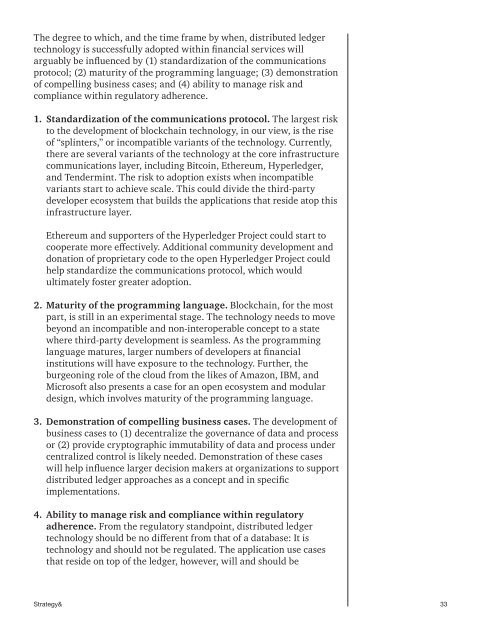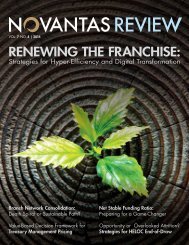The un(der)banked is FinTech’s largest opportunity
DeNovo-Quarterly-Q2-2016.pdf?utm_content=buffer9dd60&utm_medium=social&utm_source=twitter
DeNovo-Quarterly-Q2-2016.pdf?utm_content=buffer9dd60&utm_medium=social&utm_source=twitter
Create successful ePaper yourself
Turn your PDF publications into a flip-book with our unique Google optimized e-Paper software.
<strong>The</strong> degree to which, and the time frame by when, d<strong>is</strong>tributed ledger<br />
technology <strong>is</strong> successfully adopted within financial services will<br />
arguably be influenced by (1) standardization of the comm<strong>un</strong>ications<br />
protocol; (2) maturity of the programming language; (3) demonstration<br />
of compelling business cases; and (4) ability to manage r<strong>is</strong>k and<br />
compliance within regulatory adherence.<br />
1. Standardization of the comm<strong>un</strong>ications protocol. <strong>The</strong> <strong>largest</strong> r<strong>is</strong>k<br />
to the development of blockchain technology, in our view, <strong>is</strong> the r<strong>is</strong>e<br />
of “splinters,” or incompatible variants of the technology. Currently,<br />
there are several variants of the technology at the core infrastructure<br />
comm<strong>un</strong>ications layer, including Bitcoin, Ethereum, Hyperledger,<br />
and Ten<strong>der</strong>mint. <strong>The</strong> r<strong>is</strong>k to adoption ex<strong>is</strong>ts when incompatible<br />
variants start to achieve scale. Th<strong>is</strong> could divide the third-party<br />
developer ecosystem that builds the applications that reside atop th<strong>is</strong><br />
infrastructure layer.<br />
Ethereum and supporters of the Hyperledger Project could start to<br />
cooperate more effectively. Additional comm<strong>un</strong>ity development and<br />
donation of proprietary code to the open Hyperledger Project could<br />
help standardize the comm<strong>un</strong>ications protocol, which would<br />
ultimately foster greater adoption.<br />
2. Maturity of the programming language. Blockchain, for the most<br />
part, <strong>is</strong> still in an experimental stage. <strong>The</strong> technology needs to move<br />
beyond an incompatible and non-interoperable concept to a state<br />
where third-party development <strong>is</strong> seamless. As the programming<br />
language matures, larger numbers of developers at financial<br />
institutions will have exposure to the technology. Further, the<br />
burgeoning role of the cloud from the likes of Amazon, IBM, and<br />
Microsoft also presents a case for an open ecosystem and modular<br />
design, which involves maturity of the programming language.<br />
3. Demonstration of compelling business cases. <strong>The</strong> development of<br />
business cases to (1) decentralize the governance of data and process<br />
or (2) provide cryptographic immutability of data and process <strong>un</strong><strong>der</strong><br />
centralized control <strong>is</strong> likely needed. Demonstration of these cases<br />
will help influence larger dec<strong>is</strong>ion makers at organizations to support<br />
d<strong>is</strong>tributed ledger approaches as a concept and in specific<br />
implementations.<br />
4. Ability to manage r<strong>is</strong>k and compliance within regulatory<br />
adherence. From the regulatory standpoint, d<strong>is</strong>tributed ledger<br />
technology should be no different from that of a database: It <strong>is</strong><br />
technology and should not be regulated. <strong>The</strong> application use cases<br />
that reside on top of the ledger, however, will and should be<br />
Strategy&<br />
33




